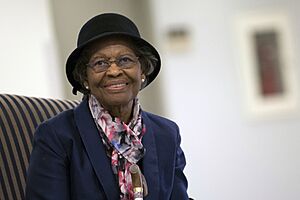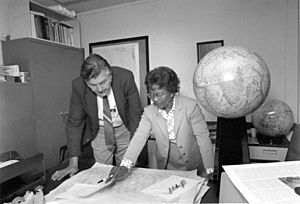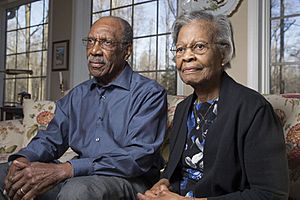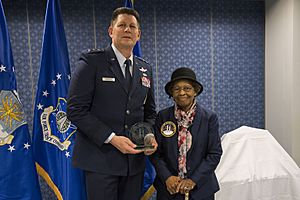Gladys West facts for kids
Quick facts for kids
Gladys West
|
|
|---|---|

West in 2018
|
|
| Born |
Gladys Mae Brown
October 27, 1930 Sutherland, Virginia, U.S.
|
| Alma mater |
|
| Known for | Satellite geodesy |
| Spouse(s) |
Ira West
(m. 1957; died 2024) |
| Children | 3 |
Gladys Mae West (née Brown; born October 27, 1930) is an American mathematician known for her contributions to the mathematical modeling of the shape of the Earth, and her work on the development of the satellite geodesy models that were eventually incorporated into the Global Positioning System (GPS). West was inducted into the United States Air Force Hall of Fame in 2018. West was awarded the Webby Lifetime Achievement Award at 25th Annual Webby Awards for the development of the satellite geodesy models.
Contents
Early life and education
West was born as Gladys Mae Brown in Sutherland, Virginia, in Dinwiddie County, a rural county south of Richmond. Her family was an African-American farming family in a community of sharecroppers. She spent much of her childhood working on her family's small farm. Her mother worked at a tobacco factory. Her father was a farmer who also worked for the railroad. West realized early on that she did not want to work in the tobacco fields or factories like the rest of her family, and decided that education would be her way out.
When West was on her way to graduate high school, but the family did nnot have enough money to send her to university. Her parents tried to save but supporting an entire family on a sharecropper's wage did not leave much left for West's education. West began babysitting to help save. At West's high school, the top two students of each graduating class received full scholarships to Virginia State College (now formally University), a historically black public university. West graduated as valedictorian in 1948, and received the much needed scholarship.
She was initially unsure what college major to pursue at VSU, as she had excelled in all her subjects in high school. She was encouraged to major in science or mathematics because of their difficulty, and West ultimately chose to study mathematics, a subject mostly studied at her college by men. She also became a member of the Alpha Kappa Alpha sorority.
West graduated in 1952 with a Bachelor of Science in mathematics. After graduating, she taught math and science for two years in Waverly, Virginia. West then returned to VSU to complete her Master of Mathematics degree, graduating in 1955. Afterward, she briefly took another teaching position in Martinsville, Virginia.
Career
In 1956, West was hired to work at the Naval Proving Ground in Dahlgren, Virginia, (now called the Naval Surface Warfare Center), where she was the second black woman ever hired and one of only four black employees.
West initially turned down the job, because she didn't have a car and couldn't find Dahlgren on a map. She also feared that they would reject her after the interview because of her race, sj she decided she'd wait to hear back from other applications. Much time went by, and no other applications were accepted elsewhere. Luckily, Dahlgren reached out to her again. They offered her the job without the need to interview. The job was offering double than her current teaching position and no other job opportunities were coming in. West was hired solely on her qualifications, with a salary that would eventually help her support her family. That was a rare find for a black woman at that time.
During her career, she encountered many hardships because of racism against African Americans. She did not receive recognition while working, while her white coworkers received praise and added privileges.
West was a programmer in the Naval Surface Warfare Center Dahlgren Division for large-scale computers and a project manager for data-processing systems used in the analysis of satellite data. Concurrently, West earned a second master's degree in public administration from the University of Oklahoma.
In the early 1960s, she participated in an award-winning astronomical study that proved the regularity of Pluto’s motion relative to Neptune. After that, West began to analyze data from satellites, putting together models of the Earth's shape. She became project manager for the Seasat radar altimetry project, the first satellite that could remotely sense oceans.
West consistently put in extra hours, cutting her team's processing time in half. She was recommended for a commendation in 1979.
The Civil Rights movement was in full swing during her time at the base. Though she supported the movement, she could not participate in protests because she was a government employee. In Boomtown, where married people lived on base, she was part of a club of black women who discussed civil rights topics.
From the mid-1970s through the 1980s, West programmed an IBM 7030 Stretch computer to deliver increasingly precise calculations to model the shape of the Earth. In her autobiography, West spoke of some of the complex problems she solved, which had proven too difficult for other members of the team. West's model ultimately became the basis for the Global Positioning System (GPS).
In 1986, West published Data Processing System Specifications for the Geosat Satellite Radar Altimeter, a 51-page technical report from The Naval Surface Weapons Center (NSWC).
West worked at Dahlgren for 42 years. She retired in 1998. After retiring, she completed a PhD in Public Administration from Virginia Tech.
Personal life
She met her husband Ira West at the Naval Surface Warfare Center Dahlgren Division, where he also worked as a mathematician. They were two of only four black employees at the time. They were married in 1957. They have three children: Carolyn, David and Michael and seven grandchildren. The West family went to Chapel on the Proving Ground every Sunday. As of February 2018[update], West lives in King George County, Virginia. Her husband died on October 20, 2024.
Interesting Facts about Gladys West
- West was inducted into the United States Air Force Hall of Fame in 2018, one of the highest honors bestowed by Air Force Space Command (AFSPC).
- As an alumna of Virginia State University Dr. Gladys West was nominated and won the award for "Female Alumna of the Year" at the Historically Black Colleges and Universities Awards sponsored by HBCU Digest in 2018.
- In 2018, West completed a PhD via a distance-learning program with the School of Public and International Affairs at Virginia Tech. She was in her late 80s at that time.
- West was selected by the BBC as part of their 100 Women of 2018.
- In 2021, she was awarded the Prince Philip Medal by the UK's Royal Academy of Engineering, their highest individual honour.
- Despite contributing to the invention of the GPS, West continues to prefer using a paper map over a tracking system, saying she still trusts her brain above all.
- Like NASA mathematicians Katherine Johnson, Dorothy Vaughan, and Mary Jackson, West is often called one of history’s “hidden figures”.
- In 2024, Virginia's Fredericksburg City School Board voted to name its third elementary school in her honor: Gladys West Elementary School.
Gladys West Quotes
- "I'm a doer, hands-on kind of person. If I can see the road and see where it turns and see where it went, I am more sure."
- “When you’re working every day, you’re not thinking, 'What impact is this going to have on the world?' You're thinking, 'I've got to get this right.'"
- "Always doing things just right, to set an example for other people who were coming behind me, especially women."
See also
 In Spanish: Gladys West para niños
In Spanish: Gladys West para niños





